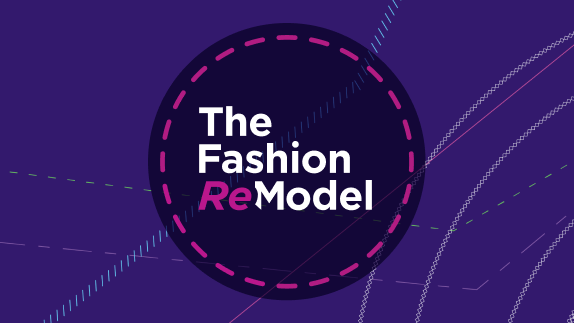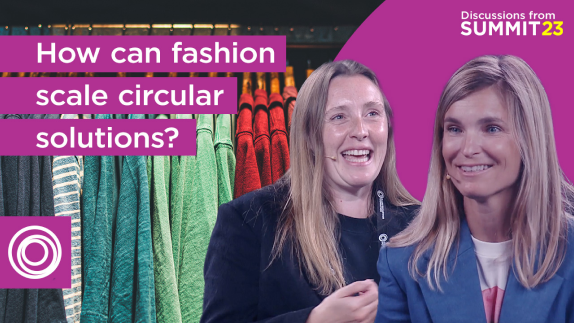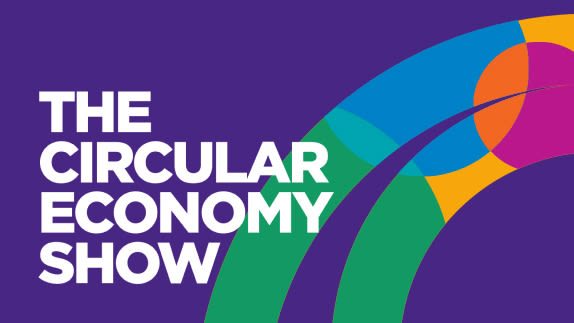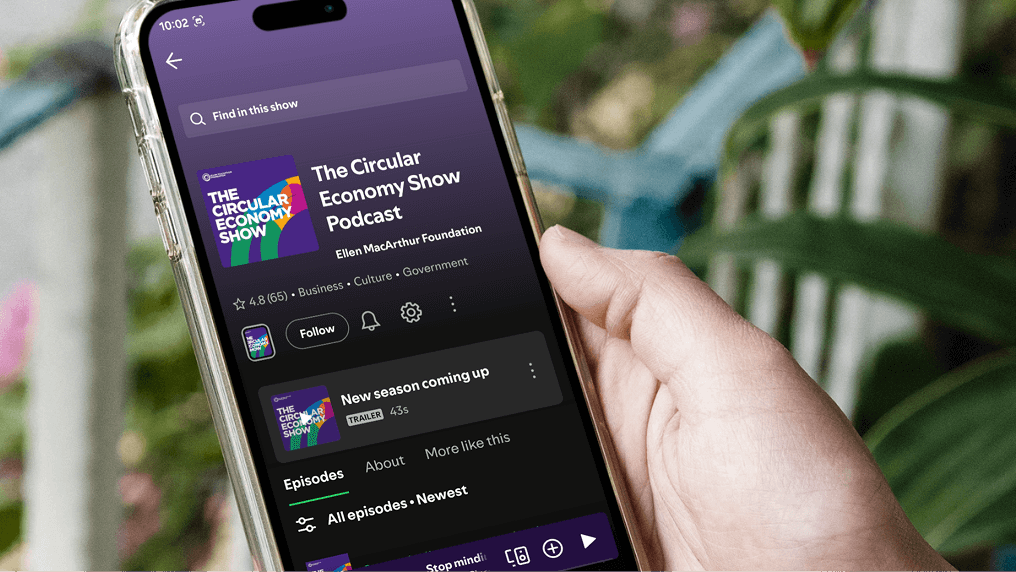Building circular business models - where products are rented, repaired, resold and remade - is key to transforming our economy from a take, make, waste linear system, to a circular one.
In this episode of the Circular Economy Show, we’re seeing what this looks like in practice with Canadian outdoor clothing and equipment company Arc’teryx.
Pippa heads to Arc’teryx’s flagship store in London to learn how the business is bringing repair in-store. Seb speaks to Katie Wilson, the company’s Director of Social and Environmental Sustainability, to hear about the strategic decisions behind this pivot.
In this episode hear about:
How Arc’teryx’s in-store ReBIRD service centres work for the business and customers
How ReBIRD is fostering deeper customer loyalty and making products accessible to new customer bases
The strategic decisions behind Arc’teryx’s shift to circular business models
The operational hurdles of implementing circular business models at scale
Arc’teryx is a participant in the Ellen MacArthur Foundation’s Fashion ReModel. Listen to episode 187 to find out more about the demonstration project, or visit the website.
The Circular Economy Show will be back in a few weeks. Let us know what you’d like to hear more about in future episodes by leaving us a review, or emailing podcast@emf.org
Click to expand
[01:00:05.760] - Adam Herron So here we are walking down to our ReBIRD service centre. This one was the first service centre available in Europe. Since then we have opened up over 15 service centres across Europe, Asia, North America and Canada. But this was the first in the UK. On the left hand side on the back bench you can see some miscellaneous tools and equipment. This guy on the far left is a leak tester. We use that particular device to test if laminated, our Gore Tex laminated jackets are actually waterproof. And we do that by applying water pressure underneath and seeing if there's any water molecules at the top. On the back bench here on the left hand side we have our die cutting machine. We use that particular device to cut away affected areas of laminated jackets and we're able to re-laminate Gore Tex panels onto and then we use the heat press there as well.
[01:00:56.570] - Pippa Shawley Building circular business models where products are repaired, reused and resold is key to transforming our economy from a take make waste linear system to a circular one. In today's episode of the Circular Economy Show we're seeing what this looks like in practise. Last week we explored the Ellen MacArthur Foundation's Fashion ReModel, a demonstration project fashion companies have joined to focus on what it will take to begin to decouple revenue from production and scale circular business models. And we heard how the H&M Group is getting involved. This week we're meeting another participant, Arc'teryx.
[01:01:39.110] I'm Pippa. And coming up we'll hear from Katie Wilson, the company's director of social and environmental sustainability, to hear about the strategic decisions behind this pivot. But first I went to the company's London flagship to find out how their repair service, ReBIRD, works in store. While large rips and repairs are sent to an off site repair facility, a large section of the store's basement floor has been given over to the ReBIRD repair space where the team can carry out small repairs for free. Adam from the team walked me through the services on offer.
[01:02:15.440] What's inside here because it looks like a laundrette.
[01:02:18.010] - Adam Herron So this is where the magic happens. This is our main attraction in this service centre. Here we can wash all of our technical garments, from our Gore Tex specific products, to our down products, to our soft shells. All of our garments do require washing. In fact, washing the garments will extend the life of a product.
[01:02:37.690] - Pippa Shawley Like the first step to circularity?
[01:02:39.610] - Adam Herron This is the first step to circularity. So we wash the garments and then we can also reapply them. Reapply the dwr. Excuse me.
[01:02:46.490] - Pippa Shawley What's DWR?
[01:02:47.490] - Adam Herron DWR is the durable water repellency that we apply to all of our garments. That specific treatment helps water repel off garments rather than absorb into the fabric.
[01:02:58.950] - Pippa Shawley While washing and reproofing jackets might sound simple, as Adam says, it's the first step towards circularity in the business, keeping products in use for longer. If you've ever felt frustrated when the zip is broken on an otherwise perfectly good jacket, or you found yourself getting slightly too well acquainted with a thicket of brambles on a hike, being able to get these repaired is a game changer. Adam says a key part of engaging Arc'teryx customers in the circular economy is knowing that these can be repaired.
[01:03:29.160] - Adam Herron So education is definitely a big part of the service as well. We have a multitude of different video resources online as well, so all of these tools are regularly available at any Arc'teryx store. So even if it doesn't have a ReBIRD service centre, our guests are able to come into any brand store and pick up a couple of sliders if they do need to do a DIY at home fix. We also provide patches as well. So yeah, if any repairs that are possible, if a guest doesn't have the jacket with them, they are able to do at home as well. A lot of these are very simple quick fixes that we do here.
[01:04:05.300] - Pippa Shawley So that's what ReBIRD looks like on the shop floor. But how did Arc'teryx reach the point of integrating repair into its business operations? Seb went to meet Katie Wilson, the company's director of social and environmental sustainability to find out.
[01:04:20.620] - Seb Read Katie, thanks for joining us on the podcast. Maybe a basic question to start. Why is Arc'teryx investing in, engaging with circular business models, new business models in the fashion space?
[01:04:35.580] - Katie Wilson Great question. We're doing it partly because we've always built really durable product and as we were really looking at our climate targets and trying to square our climate ambitions with who we are as a business, we realised that we had a real opportunity to take those durable products and that heritage of repairing and caring for those durable products and leveraging that into what different business models. So looking at how can we use that durability and create a monetised revenue stream that's lower impact than a traditional linear model.
[01:05:27.690] - Pippa Shawley So for Arc'teryx, it's not just about circularity for circularity's sake. It's about leveraging their core strength - product durability - into new lower impact revenue streams. Katie explained how this vision translates into tangible actions.
[01:05:45.640] - Katie Wilson We've taken our repair offering, which was always something that was just done in the background as a normal course of doing business. And we've really brought that to the forefront of the consumer experience. So we're starting to. We began by doing it on a small scale in some stores where we would have a repair counter and so people could come in and bring their stuff and have it assessed and usually it would get shipped back to the head office to repair. Now we're beginning to have that really at the centre of some of our retail experiences. So we opened a store in New York recently which has three floors and a whole floor is dedicated to repair and resale. And we see that that's just a really exciting opportunity for us to give our customers options because we realised that one of the barriers to circular economy is that we're not making it easy enough for people out there to participate. And we saw this repair as a really nice opportunity.
[01:06:54.260] - Pippa Shawley Making it easy for customers is key. And beyond repairs, Arc'teryx is embracing another powerful circular business model: resale.
[01:07:02.580] - Katie Wilson In a similar way, we realised that resale was a neat option as well, because with a durable product you can really do a lot of things with it. Repair is only one. Creating a marketplace for resale and giving people a way to clear out their, like an incentive to clear out their closets and bring something back and we give them a voucher which they can then spend in-store and it just creates a really nice opportunity for that gear to get reused and get a new life.
[01:07:39.200] - Seb Read So the way you described it makes a lot of sense, right? Like you have these climate ambitions. It's a revenue, you know, revenue generating opportunity. Was it easy to make the business case kind of internally? What was really key to getting some of those initiatives you described, you know, into the. Into your kind of stores, into your business model?
[01:07:57.840] - Katie Wilson Yeah, it was a joint initiative, I should say, like it was. I wasn't the initial ideator of this. I can't take credit for that. There was a joint partnership between a business development person and a sustainability person. They put their heads together and really pitched it as a win win. This is a true commercial opportunity and it's a lower revenue source of, or a lower impact source of revenue that they collaborated on that pitch, created the modelling to prove out enough of a case for it to go to pilot and get approved at a pilot stage. And then I picked up the mantle as things changed and people moved around and really brought that into a new leadership team who were extremely keen to understand more and to carry it forward. And so, along with our VP who leads the work, we Championed it and kind of made just a lot of noise, very persistent noise about it. But at the end of the day it just proved itself out as like an exciting true business opportunity. We, we gained a lot of loyalty from our customers around it and it just started to kind of sell itself internally. When we got the excitement from the market, it just became an easier. It's more like how do we just do more of it?
[01:09:39.610] - Pippa Shawley The internal buy in is there, but how are customers reacting to these offerings? Perhaps one of the most exciting outcomes beyond extending product life is how these circular business models are expanding the reach of Arc'teryx.
[01:09:53.940] - Katie Wilson What's been cool for us is to see that there's... We're quite a high priced brand. That's no secret. And there's a lot of what this has done is it's created a new opportunity for people who are fans of the brand but can't afford us to be able to acquire something that they can use and have fun with out in the mountains. So that's been I think a really nice, nice surprise.
[01:10:21.680] - Seb Read Is it opening up a new customer base in some ways.
[01:10:23.880] - Katie Wilson It is a new customer base and I know that a lot of brands and companies and our people internally as well have been concerned about things like cannibalisation of existing business and we really found that wasn't the case. I don't know if that's true for every. I think we're lucky because we do have... Being in a high price bracket. There's the room beneath that for the used pricing to make sense. So I know, but that is definitely something that we experience is that it's definitely not cannibalising anything.
[01:10:58.560] - Pippa Shawley Katie says that embracing resale in the business can open up entirely new customer bases, making quality, durable, goods accessible to more people. Back in the London store, Adam told me that the repair services were also proving a hit with existing customers and offering new opportunities for the business to connect with them.
[01:11:19.100] What's the reaction been from customers?
[01:11:20.900] - Adam Herron Overwhelmingly positive. Absolutely. We are seeing repeat business again and again. Very loyal customers. We get to have amazing conversations about garments that have been out in the field and seeing them brought back to life in a sense with quick repair solutions is what ReBIRD is all about really.
[01:11:40.780] - Pippa Shawley Have you heard some really great stories about?
[01:11:42.540] - Adam Herron Absolutely.
[01:11:43.260] - Pippa Shawley What kind of thing do you hear?
[01:11:44.860] - Adam Herron I had a gentleman summit K2. K2 is known for probably the deadliest mountain in the world. But yeah, stories from all over the world. Antarctica. Yeah. It's never ending.
[01:12:00.330] - Pippa Shawley Which is amazing to hear because often in stores you sell the clothes and then you never see them again. You never hear those stories come back.
[01:12:06.890] - Adam Herron This service centre ties in nicely for our repeat guests as well, but also for our new guests. Knowing that there is a repair, a service centre, very easily available in the heart of London where you can get your garments treated for free, you can get them repaired. It's a no brainer really.
[01:12:24.620] - Pippa Shawley And if I came in here with a ripped jacket, how long would it take you to fix it?
[01:12:29.020] - Adam Herron If it's a small repair that we can do here, five minutes at the most, we can get you out the door. Absolutely.
[01:12:35.980] - Pippa Shawley It's really efficient. So if it's raining outside, I can go back out?
[01:12:38.260] - Adam Herron Exactly, exactly, you can.
[01:12:40.370] - Pippa Shawley It's a powerful feedback loop. Not only are customers getting their gear fixed, but the brand is building deeper relationships and learning more about how their products are being used. While Arc'teryx has championed repair and resale, the process hasn't been without its hurdles. Implementing new business models, especially at a global scale, comes with its own unique set of challenges.
[01:13:03.410] - Seb Read This all sounds very positive actually. Like, it's like you've got this unstoppable momentum towards circular business models. I'm interested though also to hear about some of the challenges. Is it a yellow brick road to circular business models being 100% Arc'teryx business or what are some of those ongoing challenges you face? What directionally can you do to solve those or what are you trying to do to solve those?
[01:13:27.160] - Katie Wilson Yeah, no, it's definitely not all sunshine and roses. Yeah. Where to even start? I think the challenges are they're interesting, they can be quite boring in some ways. It's things like having a point of sale system that allows you to manage a SKU, like a single SKU, from a product that was brought into a store so you can resell it. That was a blocker for us for a long time. It's just having the headcount or capacity to go out and rebuild the system we've got in North America, in another region, because you kind of have to start from the ground up. What are the warehouses? Who are the providers? There's not a globally scaled and consistent experience and sometimes we're doing it ourselves and sometimes we've got partners. And replicating that globally is a different kind of challenge. And then I think it's looking at what are those revenue streams? Where's the legitimate revenue stream coming from? How are we making this? There's things like repairs which we offer. Is there a revenue model in there or is free the way to go and build loyalty? And if we say no to revenue and repairs, that's shutting down a whole revenue stream in the circularity space. So really teasing those conversations up and down the way I've operated in the business is really quite opportunistic. We just keep riding the waves and then when we hear things move favourably, try to strike. But it's always a little bit of a... Like the obstacles, they come and go all the time. So we're just kind of seeing how we do.
[01:15:43.370] - Pippa Shawley Arc'teryx has shown that while embracing circular business models isn't without its challenges, it's worth doing. Their commitment to ReBIRD, both repair and resale, isn't just a marketing exercise. It's a deeply integrated business strategy that's proving to be a win for their customers, their bottom line and the planet. They've leveraged their existing strength in product durability, embraced new business models and navigated the complex operational challenges along the way. The enthusiastic customer response and the new customer segments they're reaching are powerful evidence that circularity can drive loyalty and open up fresh market opportunities.
[01:16:25.880] If this episode has inspired you to find out how your business can embrace circular business models, explore our guide for fashion leaders linked in the show notes. Thanks for listening to this episode of the Circular Economy Show from the Ellen MacArthur Foundation and thanks to Katie, Adam and Seb. We're taking a few weeks off, so why not scroll through our back catalogue where you'll find many more episodes on how to scale a circular economy. And if you like what you've heard, then please leave us a review or share it with your colleagues. It really helps to spread the word.
[01:16:56.900] We'll see you next time.







